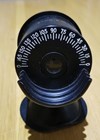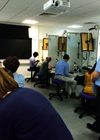Application for ophthalmic specialist training (OST) is competitive. This means you should consider making every effort to maximise your portfolio points, as it may have a significant contribution to your OST application ranking.
The “Commitment to Specialty” section is the largest section within the portfolio, and there are multiple ways in which you can earn maximum points for this. Passing the Refraction Certificate can be a surefire way to score two points, but some may consider the exam a daunting undertaking, especially for those not in ophthalmology training. Interestingly, between 2021-2022, 59-76% of people passed the exam as a non-trainee [1]. As a Foundation Year 2 doctor, I passed the Refraction Certificate exam in the December 2021 sitting. Here, I will offer some insight into the challenges you may encounter when preparing for the exam, and how you may overcome them.
Start early and begin with the basics
I started my exam preparation four months before the exam. I began my preparation by first familiarising myself with the exam structure. It is important to note that since the COVID-19 pandemic, the Refraction Certificate exam format has changed to using model eyes for the simulated retinoscopy stations. However, this is going to change again, to a hybrid format with stations involving simulated retinoscopy and real patients, from December 2022 [1]. Given this exam structure, I would recommend spreading your time evenly between practicing on simulated retinoscopy and with real patients.
Next, I studied the background knowledge surrounding refraction. I believe that the optics knowledge covered in the FRCOphth Part 1 exam is sufficient to help you understand the theories behind refraction. Otherwise, I would recommend Tim Root’s resources on optics and retinoscopy – his website offers excellent free resources (both text and video) that covers the key concepts in retinoscopy [2]. I also read Refraction and Retinoscopy: How to Pass the Refraction Certificate by Jonathan Park, a book which provides a clear step-by-step guide to refraction [3]. To consolidate your understanding, you can try out the online retinoscopy simulator [4]. Finally, to put these theories into practice, I recommend learning from an optometrist; it is through an optometrist that I learnt good practices and to fine-tune my skills. If you work in hospitals with an ophthalmology department, it is worth approaching an optometrist and learning from them if possible. Otherwise, you may consider a Refraction Exam course organised by various companies, but these may come with a steep price tag.
Practice, practice, practice
After learning the basic practical steps, it is time to practice! For this, I bought a model eye and borrowed a retinoscope and a set of trial lenses from the ophthalmology department. Even though the new exam format will involve a mix of retinoscopy stimulators and real patients, it is still worth gaining confidence in refraction using model eyes, especially in the early stages of your preparation. For instance, I was initially struggling with refracting real patients, especially with identifying the neutralised red-reflex. After many practices on a model eye, I became more confident and comfortable in refracting real patients.
Furthermore, I recommend timing yourself during practices. In the exam, you have five minutes to complete each station, which is to determine refractive status of one eye or to neutralise one pair of spectacles, and record your answer within this time. This time constraint can be a deciding factor in passing or failing the exam. Hence, throughout my practices, I aimed to complete refraction / lens neutralisation within two to three minutes, which became possible after completing approximately 80 practices on a model eye, 20 focimeter practices and 20 practices on real patients.
On the day
On the day, you will be given scrap papers, a pen and a spare retinoscope for you to borrow (please check with the exam administrators if this is still the case for your exam sitting). It is a good idea to bring your own retinoscope to the exam as you are likely more familiar with using it. At the exam, you will start on one of the 10 stations and rotate alongside other candidates through the stations. I recommend that you treat each station individually, i.e. if you feel that you have performed poorly in one station, try to forget about it and move on once you have finished. After all, you are not required to pass all stations to achieve an overall pass. In fact, I started on the ‘most difficult’ station in the exam, evident by its lowest pass rate according to the exam feedback. I was filled with self-doubt and felt slightly defeated after that first station, but reminded myself that I should try my best to complete the rest of the exam. In the end, I failed that station but still achieved an overall pass.
References
1. Refraction Certificate. The Royal College of Ophthalmologists.
https://www.rcophth.ac.uk/examinations/
rcophth-exams/refraction-certificate/
2. Tim Root. https://timroot.com/
3. Park J, Jones D. Refraction and Retinoscopy: How to Pass the Refraction Certificate. CRC Press. Boca Raton, USA; CRC Press; 2017.
4. Orge FH, Epley KD. Retinoscopy Simulator. The American Academy of Ophthalmology.
https://www.aao.org/interactive-tool/
retinoscopy-simulator
[All links last accessed March 2023].
COMMENTS ARE WELCOME











